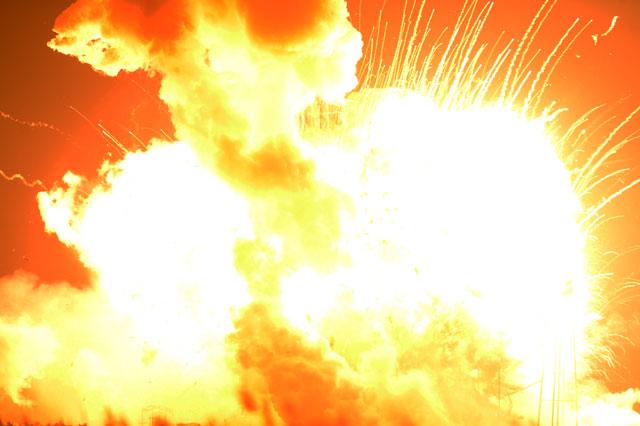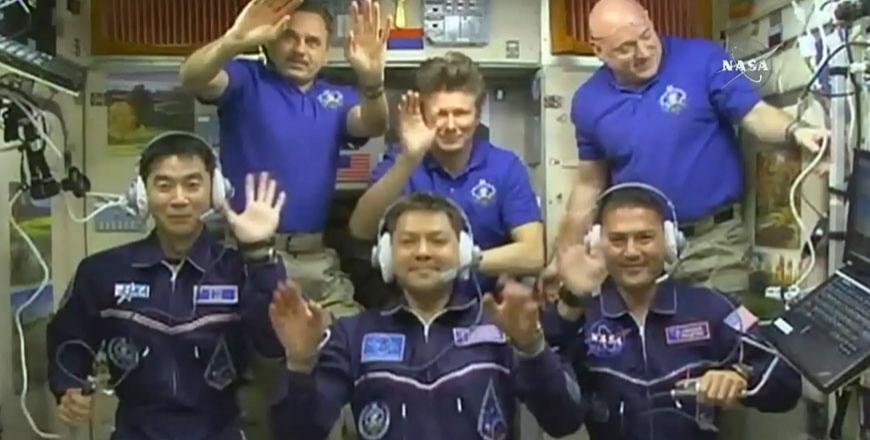You are here
US rocket explosion probed; space station resupplied
By Reuters - Oct 29,2014 - Last updated at Oct 29,2014

WALLOPS, Virginia — Authorities on Wednesday started investigating what made an unmanned US supply rocket explode in a fireball moments after lifting off from a launch pad in Virginia, destroying supplies and equipment bound for the International Space Station.
The 14-storey Antares rocket, built and launched by Orbital Sciences Corp., blasted off from the Wallops Flight Facility at 6:22pm (2222 GMT) on Tuesday but burst into flames moments later, the first disaster since NASA turned to private operators to run cargo to the space station.
Orbital Sciences stock fell 15.9 per cent to $25.54 on Wednesday.
The rocket was carrying a Cygnus cargo ship with a 2,273kg payload for the station, a $100 billion research laboratory owned and operated by 15 nations that orbits about 418km above Earth.
The loss of the supply vessel posed no immediate problem for the orbiting station's six crew: two from NASA, one from the European Space Agency and three Russians, officials said.
"There was no cargo that was absolutely critical to us that was lost on that flight. The crew is in no danger," National Aeronautics and Space Administration Associate Administrator William Gerstenmaier said.
Russia's Roskosmos space agency said it was ready to help ferry extra US cargo to the space station if NASA requested. The station is overseen by Russia and the United States, whose relations are at a low ebb over the Ukraine crisis.
The unmanned Russian Progress supply vehicle launched from Baikonur Cosmodrome in Kazakhstan hours after the explosion and the capsule, carrying more than 2273kg of food, fuel and supplies, reached the station at 9:08am
(1308 GMT).
No one was hurt in the US accident but witnesses said the explosion shook buildings for kilometres around and described a massive ball of fire lighting up the evening sky.
In the control room, reaction was a mix of "shock and professionalism”, said Frank Culbertson, Orbital Executive Vice President and mission director.
"Everyone did their job and secured the data and assessed what we had going and made sure that everything was safe and secure and then we went through our contingency plan."
Within a few days, he said, investigators would have a "pretty good idea" of where the failure began. "What exactly caused it may take a little bit longer and corrective action probably will take some time, from weeks to months," he added.
The area around the Wallops Flight Facility was cordoned off on Wednesday and a helicopter circled overhead, surveying.
Ronda Miller, manager of the Ocean Deli in Wallops Island, Virginia, told Reuters she felt the force of the blast, about 8km from the launch pad.
"We were standing outside waiting for it to launch and we saw bright red, and then we saw a big black cloud, and it shook the whole building where we work," Miller said.
The Cygnus mission was non-military but the company's Antares programme manager, Mike Pinkston, said the craft included "some classified cryptographic equipment, so we do need to maintain the area around the debris in a secure manner".
Russian rocket engines
The Antares is powered by the AJ-26 engine built by GenCorp Inc. division Aerojet Rocketdyne. In May, an AJ-26 exploded during a ground test at NASA's Stennis Space Centre in Mississippi. GenCorp shares lost 6.9 per cent to $15.99.
The accident also renewed questions about the use of Russian engines in US rockets. Congress has been concerned about Russian-made RD-180 engines that power United Launch Alliance's Atlas 5 rockets, used primarily to fly US military satellites.
The RD-180 has had no technical problems but Russia has threatened to suspend exports in response to US trade sanctions prompted by Moscow's annexation of Ukraine's Crimea region. United Launch Alliance is a partnership of Lockheed Martin and Boeing.
It was unclear how much Tuesday's explosion would cost Orbital Sciences, whose flight was partly insured. The rocket and the cargo ship it carried were valued at $200 million, Culbertson said.
Virginia-based Orbital Sciences is one of two companies NASA has hired to fly cargo to the station after NASA's space shuttles were retired. Tuesday's flight was to be the third of eight under the company's $1.9 billion contract with NASA.
The second US supply line to the station is run by privately owned Space Exploration Technologies, or SpaceX, which is preparing its fourth flight under a separate $1.6 billion NASA contract, slated for December 9.
The Cygnus carried a prototype satellite owned by Redmond, Washington-based startup Planetary Resources Inc., which is developing technology to mine asteroids.
Orbital Sciences is merging with Alliant Techsystems Inc.'s Aerospace and Defence division, a deal analysts expect to close sometime early next year.
Related Articles
An unmanned Space Exploration Technologies mission blasted off on Saturday carrying cargo for the International Space Station, but efforts to reland the rocket on a sea platform failed, the firm said.
MOSCOW — Astronauts from Russia, Japan and the United States Thursday docked successfully with the International Space Station after a two-m
WASHINGTON — A rocket’s dead, blown to bits in public view.


















